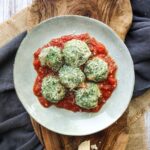
Gnudi are soft and light-as-a-cloud balls of ricotta and spinach, like the filling of the classic ravioli but without the pasta. They are a traditional dish in Tuscany and they're usually served with butter and sage or with a flavorful tomato sauce.

Gnudi, are a gem in Tuscan cuisine, they shine through their simplicity and depth of flavor. Unlike the potato-based gnocchi, Gnudi are made with ricotta cheese and spinach, the same filling as Ravioli, or Cannelloni, but without the pasta. This recipe is perfect for those seeking to bring a piece of Italy into their home kitchens. The combination of fresh, wholesome ingredients with a touch of nutmeg and Parmesan cheese creates a dish that's not only easy to prepare but also steeped in tradition and taste.
Check out also this post with 50+ Best Authentic Vegetarian Italian Recipes.
Jump to:
What are Gnudi?
The word "Gnudi" literally means "naked" in Tuscan dialect. And the reason it's quite simple. Gnudi are practically dumplings made with the filling of the classic Ravioli or Cannelloni: Ricotta and Spinach. So it's like naked Ravioli, stripped out of its pasta clothes.
This recipe has ancient origins in the countryside of Tuscany, where peasants were growing vegetables and having cow farms. That's why the original recipe is made with cow's milk Ricotta, although nowadays is common to also use sheep's milk Ricotta. They're very similar to Ricotta Gnocchi but with the addition of greens. If spinach was not available, it was common to use other greens to make Gnudi, like chards or kale.
🧾Ingredients
- Ricotta Cheese: Fresh Ricotta cheese is a soft, creamy, and mild Italian cheese made from the whey left over from the production of other cheeses. It's white, with a slightly sweet taste and a grainy texture. Opt for whole-milk ricotta cheese for its creaminess.
- Spinach: I prefer to use frozen spinach but you can also use fresh if you prefer.
- Parmesan Cheese: Parmesan cheese is a hard, aged Italian cheese with a rich, nutty flavor and a grainy texture. It's made from cow's milk and aged for at least 12 months. Adds a salty, umami depth to the gnudi.
- Egg: Acts as a binder for the spinach and ricotta gnocchi mixture.
- Nutmeg: Provides a subtle warmth to the gnudi. It's a spice very commonly used in Italian recipes.
- All-Purpose Flour: It's used for dusting and binding. You can also use gluten-free flour or wholemeal flour, if you prefer.
🍳Substitutions
When looking for substitutions in Gnudi recipes, you can focus on each main component for alternatives that maintain the dish's integrity while accommodating dietary restrictions, availability issues, or flavor preferences. Here's a list of substitutions:
- Ricotta Cheese: Use cottage cheese (drained and blended) or silken tofu (for a vegan alternative) to closely mimic ricotta's texture.
- Spinach: Swiss chard or kale (finely chopped) can replace spinach, offering a similar texture with a slight variation in flavor.
- Flour: Gluten-free flour mixes or almond flour work well for those avoiding gluten or seeking a low-carb option.
- Parmesan Cheese: Substitute with Pecorino Romano for a saltier taste or nutritional yeast for a vegan, cheesy flavor.
- Nutmeg: Mace or a pinch of cinnamon can be used as a substitute for a similar warmth and sweetness.
- Egg: Flaxseed meal or chia seeds mixed with water create vegan alternatives that help bind the ingredients together.
🥣Variations
Creating variations of the ricotta Gnudi recipe can introduce delightful twists to this traditional Tuscan dish. Here’s a list of ideas to experiment with, altering either the flavor profile, the ingredients for dietary needs, or simply for a creative change:
- Herb-Infused Gnudi: Mix fresh herbs like basil, thyme, or rosemary into the ricotta-spinach mixture for a fragrant touch.
- Pumpkin or Squash Gnudi: Replace spinach with pureed pumpkin or butternut squash for a sweet, autumnal variant.
- Cheese Variety Gnudi: Experiment with different cheeses such as Gorgonzola for a stronger flavor, or mix mozzarella for a softer texture.
- Gluten-Free Gnudi: Use a gluten-free flour blend instead of regular flour to cater to gluten sensitivities without compromising on texture.
- Vegan Gnudi: Substitute ricotta with blended silken tofu and use a flax or chia egg, ensuring all other ingredients are vegan-friendly.
- Lemon Zest and Ricotta Gnudi: Add lemon zest to the ricotta-spinach mix for a fresh, citrusy note that pairs wonderfully with light, creamy sauces.
- Sweet Potato Gnudi: Incorporate mashed sweet potato in place of or alongside spinach for a subtly sweet and colorful variation.
- Spicy Gnudi: Spice things up by adding finely chopped chili peppers or a dash of red pepper flakes into the mixture for a kick.
📋Instructions
- Sautè the spinach in olive oil with garlic on medium heat. Then drain the excess water and set aside to cool down.
- In a large bowl, mix the ricotta, with the egg and add the finely chopped spinach, seasonings, and half the flour. Start with a small amount of flour and add more until you get the right consistency. The dough should be soft but now liquid.
- Roll the dough into little balls and roll them in flour. Set aside on a plate to rest.
- Boil the Gnudi in a large pot of salted water for 2-3 minutes or until they float to the surface of the water, and drain with a slotted spoon.
- Add the cooked Gnudi into the sauce of choice.
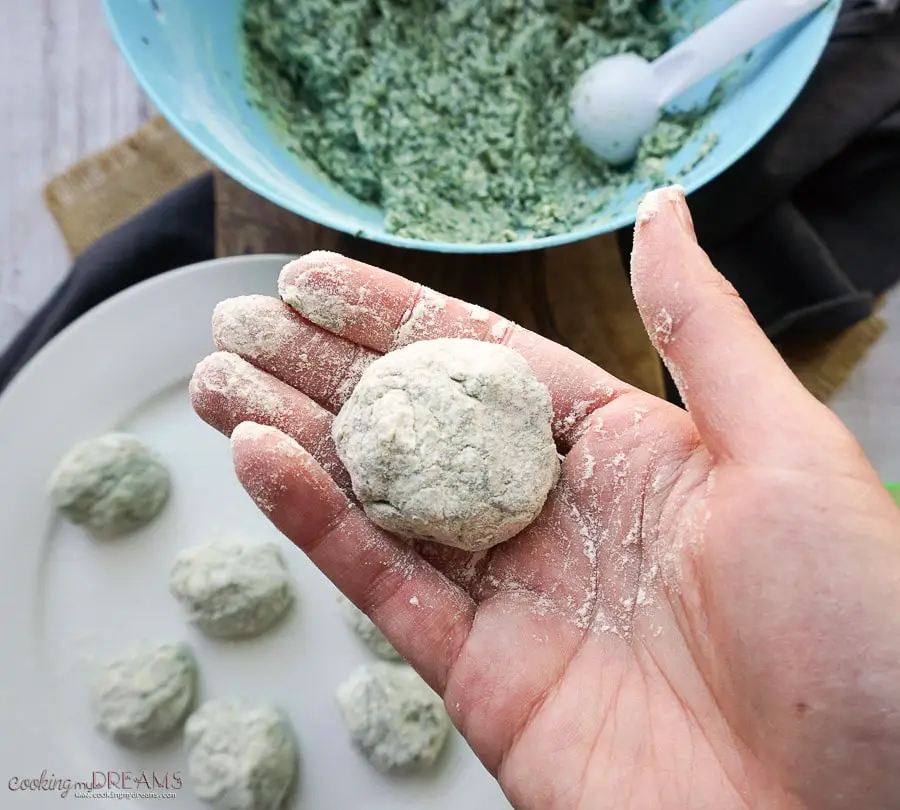
🍽 Serving Suggestions
Gnudi, with their soft, pillowy texture, pair beautifully with a variety of sauces and accompaniments, allowing for versatility in serving options.
A classic choice is a simple sage and butter sauce, where the nuttiness of brown butter and the earthy tones of sage highlight the delicate flavors of the gnudi. For something heartier, a simple tomato sauce can envelop the gnudi in a robust, comforting embrace. If you're looking for a lighter option, a drizzle of high-quality olive oil, a sprinkle of fresh herbs, and a dusting of Parmesan cheese can elevate the gnudi without overwhelming their subtle taste.
For a refreshing contrast, serve alongside a crisp, green salad dressed with a vibrant vinaigrette. Whether you opt for something simple or more elaborate, the key is to complement the ricotta dumplings's flavors and textures without overpowering them, ensuring a harmonious dish that delights the palate.
❄️ Storage & Reheating
Storing and reheating Gnudi requires a bit of care to maintain their delicate texture. If you have leftovers, it's best to refrigerate them in an airtight container as soon as they've cooled down, where they can last for up to two days. To reheat, gently warm them in a covered skillet over low heat with a splash of water or broth to prevent drying out, stirring carefully to ensure even heating.
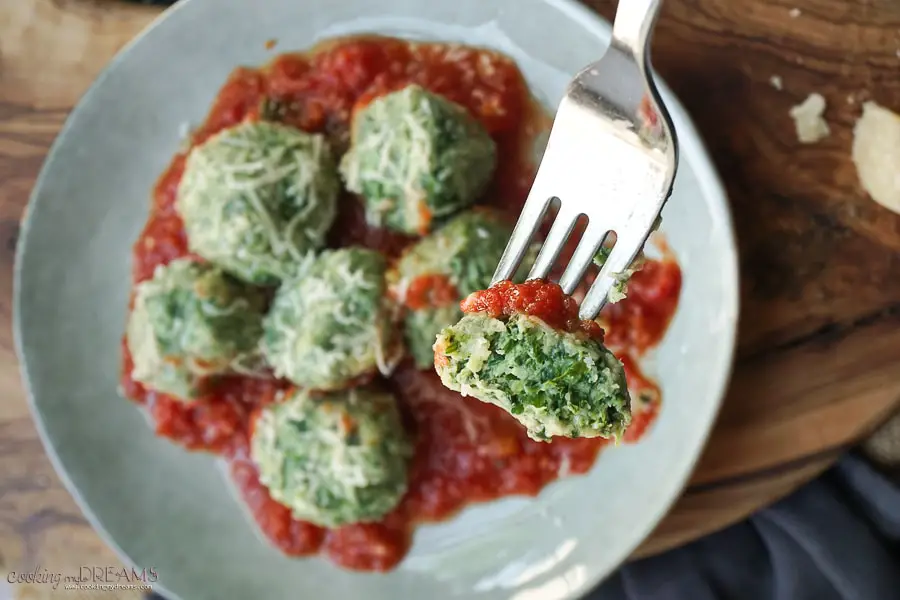
💭 Recipe FAQs
Yes! Just like pasta and gnocchi, it's very easy to freeze Gnudi. After you created your dumplings, coat them in flour or corn starch and place them on a plate covered with parchment paper, making sure they're well distanced and not touching each other. Put the plate in your freezer and freeze for about 1 hour. Then you can remove the dumplings from the plate and add them in a freezer bag. You can keep them frozen for about 1 month. When you're ready to cook, toss them directly in salted boiling water without thawing first.
A: Ensure your Gnudi mixture is not too wet, and be gentle when forming the dumplings. Cook them in a gently simmering, not boiling, pot of water to prevent them from breaking apart.
Yes, you can prepare Gnudi ahead of time. Form the dumplings and place them on a flour-dusted tray, then cover and refrigerate for up to a day before cooking.
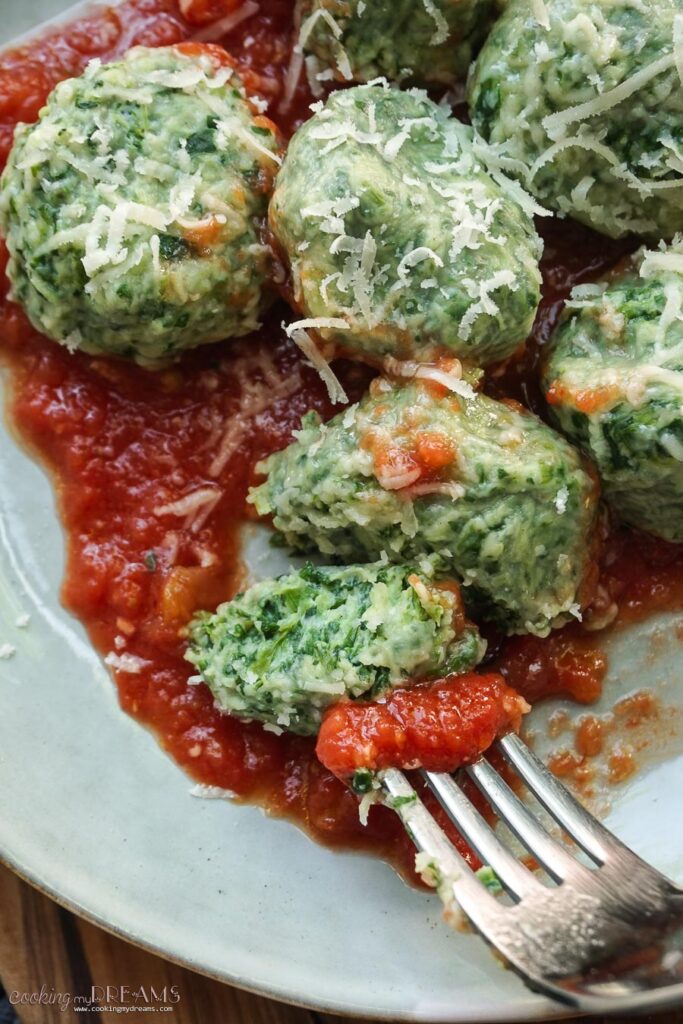
Related Recipes you might like
If you like this recipe, try also these other Tuscan recipes:
- Classic Tuscan Lasagna
- "Pappa al Pomodoro" Tuscan bread and tomatoes
- "Tortelli Mugellani" Tuscan Potato Ravioli
If you tried this recipe, please take a moment to rate it and share your thoughts in the comments. Your feedback means a lot to me! ★★★★★
📖 RECIPE

"Gnudi" Spinach and Ricotta Gnocchi
Ingredients
For the Gnudi
- 1 Garlic clove
- 14 oz Frozen Spinach, see Notes for fresh spinach
- 9 oz fresh Ricotta
- 5 tablespoon Parmigiano cheese, grated
- 1 Egg yolk
- 7 tablespoon All Purpose Flour
- Salt
- Black Pepper
- Nutmeg, ground
For the Tomato Sauce
- 1 Garlic clove, minced
- 10.5 oz Tomato purèe
- 3-4 Basil leaves
- Olive Oil
- Salt
Instructions
Make the Sauce
- In a pot, add the olive oil, the minced garlic and the tomato sauce. Bring to a simmer then add the basil leaves and lower the heat. Simmer for about 20 minutes. Season with salt and pepper to taste.
Make the Gnudi
- In a pan, drizzle the olive oil and add the halved garlic clove and the spinach. Season with salt, pepper and ground nutmeg and sautè for about 5 minutes.
- Drain the excess liquids as much as possible, by squeezing the spinach, then set them aside in a bowl to cool down.
- Meanwhile, bring a large pot of salted water to boil.
- Add the cooled spinach to the ricotta cheese, add the Parmigiano cheese and season again if needed. Then add the egg yolk and half of the flour.
- Mix all the ingredients and add more flour until you get a thicker consistency.
- With a tablespoon, make the balls and roll them in flour. Set them on a plate or floured surface to rest. If they seem too soft, you may want to test one in boiling water. If it melts and doesn't keep the shape, you will need to add more flour to the dough.
- When they're all ready, toss them gently in the boiling water one by one.
- Boil for 2-3 minutes, until they come up to the surface. Remove them with a skimmer and add them to the tomato sauce or directly in the serving plates.
Notes
Nutrition
Nutritional information is only an estimate. The accuracy of the nutritional information for any recipe on this site is not guaranteed.


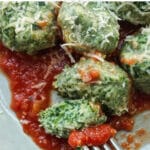

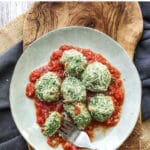
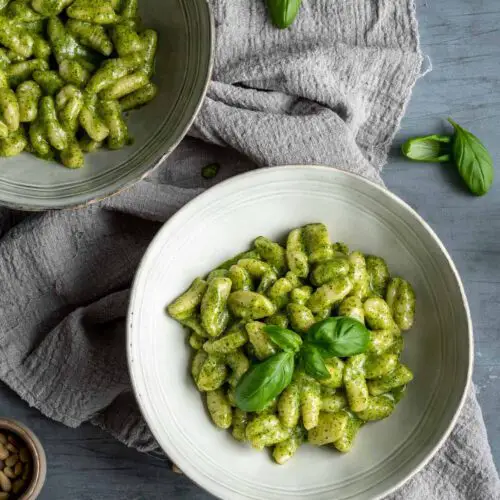


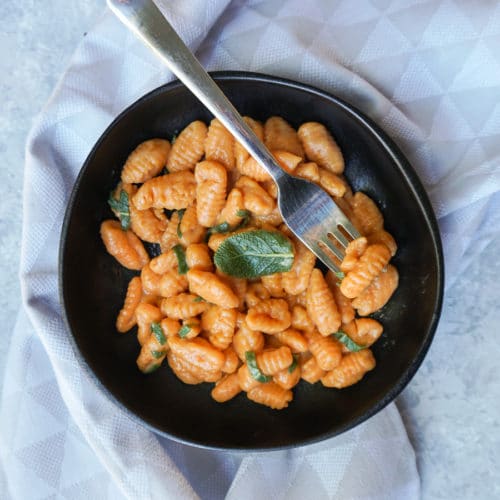
Leave a Comment